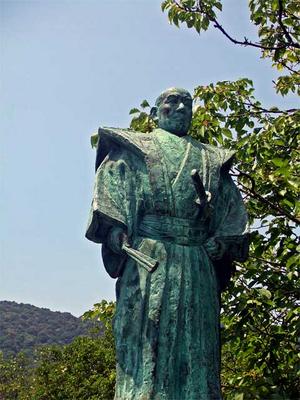
Iwakuni lies just a single shinkansen stop outside of Hiroshima: about 40 miles away and yet only 15 minutes by bullet train. I have always visited this town as a kid, but never really toured and explored it. My family only visited Iwakuni’s Kintaikyo, one of Japan’s most famous bridges, and then we would leave Iwakuni (which is also the site of a U.S. marine base). So today, I look forward to the trip to this former castle town. It was built by Lord Kikkawa, the ancestor of one of my good friends in Hawaii, and so I have an interest in seeing the Kikkawa family museum and graves.
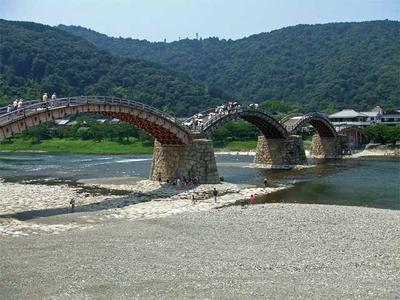
Kintaikyo Bridge, a famous landmark
One thing you will note is that Iwakuni typifies how Japanese love replicas and recreations. The Kintaikyo Bridge was washed away by a typhoon around 1952, and what we see today is...surprise...a replica. The Iwakuni Castle overlooking the city from the mountains was destroyed in the early sixteenth century by order of the Tokugawa Shogun, who only allowed one castle per domain, and this replica was rebuilt in 1962 or so, some yards from its original location. In fact, almost everywhere you go, like Kintaikyo in Kyoto, or the Statue of Liberty in Tokyo, you will see crowds of tourists taking pictures of replicas built in the 20th century. Now if you are a purist, you can see this as a cheap attraction to kitschy replicas, but if you are Buddhist, you can see this as a lesson on the non-permanence of things. For buildings to disappear and be rebuilt is akin to the cycle of reincarnation. Anyway, now you understand why Japanese can so easily accept the replicas at Disneyland and DisneySea – replicas are famous tourist attractions in Japan!
Anyway, I went to the Kikkawa family museum, which was set in what used to be the Kikkawa family manor (not a replica), and saw the family heirlooms such as scrolls, swords, and paintings. Here is a picture of the main gate to the museum.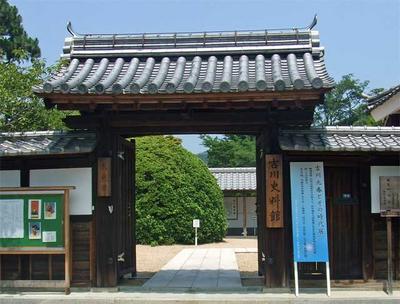
Iwakuni is also famous for its white snakes. They must have come from some sort of mutation, and because they were seen as good luck omen, they were left alone, and so their numbers increased over the centuries. Aren’t they cute? 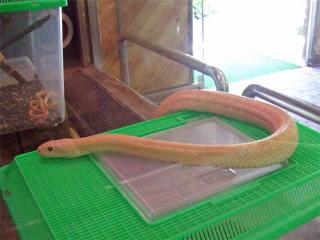 Environmental degradation, however, had reduced their number, and so an effort is underway to breed more of these snakes. Here is a cute cartoon from the Iwakuni White Snake Village.
Environmental degradation, however, had reduced their number, and so an effort is underway to breed more of these snakes. Here is a cute cartoon from the Iwakuni White Snake Village.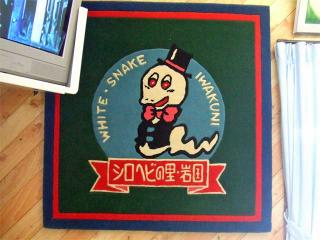
Then we went to the ropeway at the base of the hills to get to Iwakuni castle. It felt so much cooler in the hills, and the five minute walk in the forest to the castle was quite enjoyable. I saw a sign featuring crying trees and sad animals to tell you not to throw cigarettes into the forest. Isn`t pity a much better way to move people than scolding them? 
I wonder why Lord Kikkawa chose to destroy this pleasantly cool castle with such a fine view of the city and instead opt to live in the hot and humid lowlands?Anyway, I walked around this splendid replica of a castle, enjoyed photgraphing it under clear blue skies, and then it was time to go.
Afterwards, we went back down the hills, and then visited the Iwakuni City Museum and enjoyed viewing the fine armor collection while enjoying air-conditioned comfort. Yes, go to museums so you can enjoy their air-conditioner. Then we wentto the Kikkawa family graves, and saw lots of graves of the Kikkawa daimyo and their first and second wives. And sons. And daughters. We are talking lots and lots of graves. And no one in sight. I felt reluctant to take a photo fearing a ghost might appear on my print.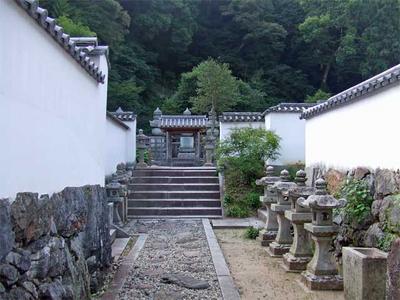 It did feel quite creepy being surrounded by so many graves and so we beat an exit out of there.
It did feel quite creepy being surrounded by so many graves and so we beat an exit out of there.
On the way back home, we saw a parade led by children carrying an omikoshi (portable shrine) to each store. Merchants would splash water on them for good luck. I like the way children are involved in traditions over in this country.
I also, on the return trip over the bridge, saw lots of Japanese mothers with their half-white or half-black children, a reminder that this is a military base town as well. This mom was yelling to her kids in Japanese, and they were talking back in Japanese. It also felt good to see my global counterparts – I look Japanese/Chinese (depending on who you ask) but speak English as my mother tongue, while they look white or black, and yet speak Japanese as their native language. That is one way to get rid of racism - have all of us marry each other. These mixed children will be Japan`s bridge to internationalization. How apt that they are on a bridge in this photo.
It also felt good to see my global counterparts – I look Japanese/Chinese (depending on who you ask) but speak English as my mother tongue, while they look white or black, and yet speak Japanese as their native language. That is one way to get rid of racism - have all of us marry each other. These mixed children will be Japan`s bridge to internationalization. How apt that they are on a bridge in this photo.
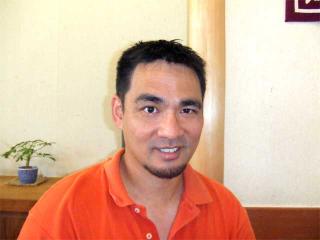
No comments:
Post a Comment